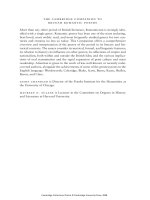The cambridge companion to british roman 51
Bạn đang xem bản rút gọn của tài liệu. Xem và tải ngay bản đầy đủ của tài liệu tại đây (39.01 KB, 1 trang )
The living pantheon of poets in 1820
Even Wordsworth offered his own kind of counter to popular romances in
The White Doe of Rylstone; or, the Fate of the Nortons (1815), and then in
Peter Bell.
The poets of 1820 offered a host of different kinds of tales: Croly called his
The Angel of the World an “Arabian Tale,” and his Sebastian a “Spanish”
one, which is how Mary Leman Grimstone also labeled her “Zayda.” Hunt
offered his translation of Amyntas as “A Tale of the Woods.” Nodier’s Giovanni Sbogarro was translated as “A Venetian Tale (Taken from the French).”
Caroline Bowles Southey published her Fitzarthur as a “Metrical Tale.” Bulwer Lytton’s first volume of poetry opened with “Ismael, An Oriental Tale.”
William Herbert issued Hedin; or, The Spectre of the Tomb. A Tale. From
the Danish History. John Roby published Lorenzo, or The Tale of Redemption. Mr. Frankly printed his Omar and Zara, or, The Power of Truth, A
Father’s Tale in Verse. John Brown released Legitimacy, a Poem; or, Leonard
and Louisa, A Tale for our Times; and “Old Tom of Oxford” published
Solomon Logwood, A Radical Tale, with satire again providing modal variations on other forms.
Keats, identified on the title page of the 1820 volume as the author of his
poetical romance Endymion, does not provide his three opening poems with
generic markers, but they have long been recognized as innovative interventions into the contemporary construction of the romance or tale, a point
which, again, can be fully appreciated only if we return these poems to the
larger pantheon of poetry into which they were introduced. Curran suggests
that Keats’s three tales provide a synoptic history of romance offering poems
“in the mode of the Greek (in couplets), Italian (in ottava rima) and British (in
Spenserian stanzas).”33 Keats here may have been following Dryden, whose
Fables Ancient and Modern (1700) also modernize classical (Ovid), Italian
(Boccaccio), and English (Chaucer) romances, but he is also seeking to assert
his experimental modernity by demonstrating that he can master and transform the entire range of romance. We see similar gatherings of tales covering
a range of models, usually to point toward a kind of world or global literature, so that Croly offers both a “Spanish” and an “Arabian” romance, or
Procter produces two stories from Boccaccio alongside “Gyges,” a classical
story in the style of Byron’s Don Juan, “The Death of Acis,” labeled “A tale
Sicilian” (l. 2), and “Diego de Montilla. A Spanish Tale.” Procter provides
a particularly good point of comparison for his fellow Cockney, Keats, for
both are engaged in exploring world literature’s tales and more specifically
in adapting Boccaccio, a project in which Keats would also be joined by
Reynolds. Like Procter, Keats, whose “Fancy,” also included in the volume,
proclaims “Ever let the fancy roam, / Pleasure never is at home” (ll. 1–2),
29
Cambridge Collections Online © Cambridge University Press, 2008









